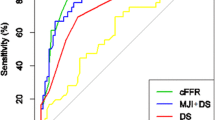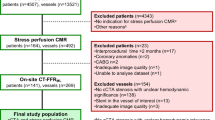Abstract
Objectives
To compare the diagnostic performance of machine learning (ML)–based computed tomography–derived fractional flow reserve (CT-FFR) and cardiac magnetic resonance (MR) perfusion mapping for functional assessment of coronary stenosis.
Methods
Between October 2020 and March 2022, consecutive participants with stable coronary artery disease (CAD) were prospectively enrolled and underwent coronary CTA, cardiac MR, and invasive fractional flow reserve (FFR) within 2 weeks. Cardiac MR perfusion analysis was quantified by stress myocardial blood flow (MBF) and myocardial perfusion reserve (MPR). Hemodynamically significant stenosis was defined as FFR ≤ 0.8 or > 90% stenosis on invasive coronary angiography (ICA). The diagnostic performance of CT-FFR, MBF, and MPR was compared, using invasive FFR as a reference.
Results
The study protocol was completed in 110 participants (mean age, 62 years ± 8; 73 men), and hemodynamically significant stenosis was detected in 36 (33%). Among the quantitative perfusion indices, MPR had the largest area under receiver operating characteristic curve (AUC) (0.90) for identifying hemodynamically significant stenosis, which is in comparison with ML-based CT-FFR on the vessel level (AUC 0.89, p = 0.71), with comparable sensitivity (89% vs 79%, p = 0.20), specificity (87% vs 84%, p = 0.48), and accuracy (88% vs 83%, p = 0.24). However, MPR outperformed ML-based CT-FFR on the patient level (AUC 0.96 vs 0.86, p = 0.03), with improved specificity (95% vs 82%, p = 0.01) and accuracy (95% vs 81%, p < 0.01).
Conclusion
ML-based CT-FFR and quantitative cardiac MR showed comparable diagnostic performance in detecting vessel-specific hemodynamically significant stenosis, whereas quantitative perfusion mapping had a favorable performance in per-patient analysis.
Clinical relevance statement
ML-based CT-FFR and MPR derived from cardiac MR performed well in diagnosing vessel-specific hemodynamically significant stenosis, both of which showed no statistical discrepancy with each other.
Key Points
• Both machine learning (ML)–based computed tomography–derived fractional flow reserve (CT-FFR) and quantitative perfusion cardiac MR performed well in the detection of hemodynamically significant stenosis.
• Compared with stress myocardial blood flow (MBF) from quantitative perfusion cardiac MR, myocardial perfusion reserve (MPR) provided higher diagnostic performance for detecting hemodynamically significant coronary artery stenosis.
• ML-based CT-FFR and MPR from quantitative cardiac MR perfusion yielded similar diagnostic performance in assessing vessel-specific hemodynamically significant stenosis, whereas MPR had a favorable performance in per-patient analysis.
Graphical Abstract






Similar content being viewed by others
Abbreviations
- AUC:
-
Area under curves
- CAD:
-
Coronary artery disease
- FFR:
-
Fractional flow reserve
- ICA:
-
Invasive coronary angiography
- ICC:
-
Intraclass correlation coefficient
- MBF:
-
Myocardial blood flow
- ML:
-
Machine learning
- MPR:
-
Myocardial perfusion reserve
- MR:
-
Magnetic resonance
- MVCAD:
-
Multivessel coronary artery disease (2- or 3-vessel obstructive disease)
- NPV:
-
Negative predictive value
- PPV:
-
Positive predictive value
- ROC:
-
Receiver operating characteristic
References
Greenwood JP, Maredia N, Younger JF et al (2012) Cardiovascular magnetic resonance and single-photo emission computed tomography for diagnosis of coronary heart disease (CE-MARC): a prospective trial. Lancet 379:453–600
Danad I, Szymonifka J, Twisk JWR et al (2017) Diagnostic performance of cardiac imaging methods to diagnose ischaemia-causing coronary artery disease when directly compared with fractional flow reserve as a reference standard: a meta-analysis. Eur Heart J 38:991–998
Arai AE, Schulz-Menger J, Berman D et al (2020) Gadobutrol-enhanced cardiac magnetic resonance imaging for detection of coronary artery disease. J Am Coll Cardiol 76(13):1536–1547
Heitner JF, Kim RJ, Kim HW et al (2019) Prognostic value of vasodilator stress cardiac magnetic resonance imaging: a multicenter study with 48000 patient-years of follow-up. JAMA Cardiol 4:256–264
Ge Y, Antiochos P, Steel K et al (2020) Prognostic value of stress CMR perfusion imaging in patients with reduced left ventricular function. JACC Cardiovasc Imaging 13:2132–2145
Nagel E, Greenwood JP, McCann GP et al (2019) Magnetic resonance perfusion or fractional flow reserve in coronary disease. N Engl J Med 380:2418–2428
Schulz-Menger J, Bluemke DA, Bremerich J et al (2013) Standardized image interpretation and postprocessing in cardiovascular magnetic resonance: Society for Cardiovascular Magnetic Resonance (SCMR) Board of Trustees Task Force on Standardized Post Processing. J Cardiovasc Magn Reson 15:35
Motwani M, Maredia N, Fairbairn TA, Kozerke S, Greenwood JP, Plein S (2014) Assessment of ischaemic burden in angiographic three-vessel coronary artery disease with high-resolution myocardial perfusion cardiovascular magnetic resonance imaging. Eur Heart J Cardiovasc Imaging 15:701–708
Kotecha T, Chacko L, Chehab O et al (2020) Assessment of multivessel coronary artery disease using cardiovascular magnetic resonance pixelwise quantitative perfusion mapping. JACC Cardiovasc Imaging 13:2546–2557
Hsu LY, Jacobs M, Benovoy M et al (2018) Diagnostic performance of fully automated pixel-wise quantitative myocardial perfusion imaging by cardiovascular magnetic resonance. JACC Cardiovasc Imaging 11:697–707
Morton G, Chiribiri A, Ishida M et al (2012) Quantification of absolute myocardial perfusion in patients with coronary artery disease: comparison between cardiovascular magnetic resonance and positron emission tomography. J Am Coll Cardiol 60:1546–1555
Rahman H, Scannell CM, Demir OM et al (2021) High-resolution cardiac magnetic resonance imaging techniques for the identification of coronary microvascular dysfunction. JACC Cardiovasc Imaging 14(5):978–986
Menke J, Kowalski J (2016) Diagnostic accuracy and utility of coronary CT angiography with consideration of unevaluable results: a systematic review and multivariate Bayesian random-effects meta-analysis with intention to diagnose. Eur Radiol 26:451–458
Meijboom WB, Van Mieghem CA, van Pelt N et al (2008) Comprehensive assessment of coronary artery stenoses: computed tomography coronary angiography versus conventional coronary angiography and correlation with fractional flow reserve in patients with stable angina. J Am Coll Cardiol 52:636–643
Koo BK, Erglis A, Doh JH et al (2011) Diagnosis of ischemia-causing coronary stenoses by noninvasive fractional flow reserve computed from coronary computed tomographic angiograms. Results from the prospective multicenter DISCOVER-FLOW (Diagnosis of Ischemia-Causing Stenoses Obtained Via Noninvasive Fractional Flow Reserve) study. J Am Coll Cardiol 58(19):1989–1997
Nakazato R, Park HB, Berman DS et al (2013) Noninvasive fractional flow reserve derived from computed tomography angiography for coronary lesions of intermediate stenosis severity: results from the DeFACTO study. Circ Cardiovasc Imaging 6(6):881–889
Nørgaard BL, Leipsic J, Gaur S et al (2014) Diagnostic performance of noninvasive fractional flow reserve derived from coronary computed tomography angiography in suspected coronary artery disease: the NXT trial (Analysis of Coronary Blood Flow Using CT Angiography: Next Steps). J Am Coll Cardiol 63(12):1145–1155
Douglas PS, Pontone G, Hlatky MA et al (2015) Clinical outcomes of fractional flow reserve by computed tomographic angiography-guided diagnostic strategies versus usual care in patients with suspected coronary artery disease: the Prospective Longitudinal Trial of FFRCT: outcome and resource impacts (PLATFORM) study. Eur Heart J 36:3359–3367
Coenen A, Kim Y-H, Kruk M et al (2018) Diagnostic accuracy of a machine-learning approach to coronary computed tomographic angiography-based fractional flow reserve: result from the MACHINE Consortium. Circ Cardiovasc Imaging 11(6):e007217
Raff GL, Abidov A, Achenbach S et al (2009) SCCT guidelines for the interpretation and reporting of coronary computed tomographic angiography. J Cardiovasc Comput Tomogr 3:122–136
Itu L, Rapaka S, Passerini T et al (2016) A machine learning approach for computation of fractional flow reserve from coronary computed tomography. J Appl Physiol (1985) 121(1):42–52
Ishida M, Schuster A, Morton G et al (2011) Development of a universal dual-bolus injection scheme for the quantitative assessment of myocardial perfusion cardiovascular magnetic resonance. J Cardiovasc Magn Reson 13:28
Benjamini Y, Hochberg Y (1995) Controlling the false discovery rate: a practical and powerful approach to multiple testing. J Roy Stat Soc B 57:289–300
Tesche C, De Cecco CN, Baumann S et al (2018) Coronary CT angiography-derived fractional flow reserve: machine learning algorithm versus computational fluid dynamics modeling. Radiology 288(1):64–72
Rønnow Sand NP, Nissen L, Winther S et al (2020) Prediction of coronary revascularization in stable angina: comparison of FFRCT with CMR stress perfusion imaging. JACC Cardiovasc Imaging 13(4):994–1004
Sand NPR, Veien KT, Nielsen SS et al (2018) Prospective comparison of FFR derived from coronary CT angiography with SPECT perfusion imaging in stable coronary artery disease: the ReASSESS study. JACC Cardiovasc Imaging 11(11):1640–1650
Aznaouridis K, Masoura K, Tousoulis D (2018) Chapter 2.3 - regulation of oxygen transport and coronary blood flow. In: Tousoulis D (ed) Coronary artery disease. Academic Press; p 137–156
Zhao SH, Guo WF, Yao ZF et al (2023) Fully automated pixel-wise quantitative CMR-myocardial perfusion with CMR-coronary angiography to detect hemodynamically significant coronary artery disease. Eur Radiol 33(10):7238–7249
Maron DJ, Hochman JS, Reynolds HR et al (2020) Initial invasive or conservative strategy for stable coronary disease. N Engl J Med 382:1395–1407
SCOT-HEART Investigators, Newby DE, Adamson PD et al (2018) Coronary CT angiography and 5-year risk of myocardial infarction. N Engl J Med 379:924–933
Hoffmann U, Ferencik M, Udelson JE et al (2017) Prognostic value of noninvasive cardiovascular testing in patients with stable chest pain: insights from the PROMISE trial (Prospective Multicenter Imaging Study for Evaluation of Chest Pain). Circulation 135:2320–2332
Foy AJ, Dhruva SS, Peterson B, Mandrola JM, Morgan DJ, Redberg RF (2017) Coronary computed tomography angiography versus functional stress testing for patients with suspected coronary artery disease: a systematic review and meta-analysis. JAMA Intern Med 177:1623–1631
Acknowledgements
The authors acknowledge Dr. Schwemmer Chris, Siemens Healthineers, Forchheim, Germany, for providing software of machine learning CT fractional flow reserve; Dr. Yihan Lu and Xue Yang, Department of Radiology, Zhongshan Hospital, Fudan University, Shanghai, China, for contributing to interpretation of coronary CTA; Dr. Yang Qiao, Department of Radiology, Zhongshan Hospital, Fudan University, Shanghai, China, for contributing to analysis of machine learning CT fractional flow reserve.
Funding
This study has received funding by Shanghai Municipal Key Clinical Specialty (grant number shslczdzk03202).
Author information
Authors and Affiliations
Corresponding author
Ethics declarations
Guarantor
The scientific guarantor of this publication is Mengsu Zeng.
Conflict of Interest
Z.X. is an employee of Siemens. The remaining authors declare no relationships with any companies whose products or services may be related to the subject matter of the article.
Statistics and Biometry
No complex statistical methods were necessary for this paper.
Informed Consent
Written informed consent was obtained from all subjects (patients) in this study.
Ethical Approval
Institutional review board approval was obtained.
Study subjects or cohorts overlap
None.
Methodology
• prospective
• diagnostic or prognostic study
• performed at one institution
Additional information
Publisher's Note
Springer Nature remains neutral with regard to jurisdictional claims in published maps and institutional affiliations.
Supplementary Information
Below is the link to the electronic supplementary material.
Rights and permissions
Springer Nature or its licensor (e.g. a society or other partner) holds exclusive rights to this article under a publishing agreement with the author(s) or other rightsholder(s); author self-archiving of the accepted manuscript version of this article is solely governed by the terms of such publishing agreement and applicable law.
About this article
Cite this article
Guo, W., Zhao, S., Xu, H. et al. Comparison of machine learning–based CT fractional flow reserve with cardiac MR perfusion mapping for ischemia diagnosis in stable coronary artery disease. Eur Radiol (2024). https://doi.org/10.1007/s00330-024-10650-6
Received:
Revised:
Accepted:
Published:
DOI: https://doi.org/10.1007/s00330-024-10650-6




